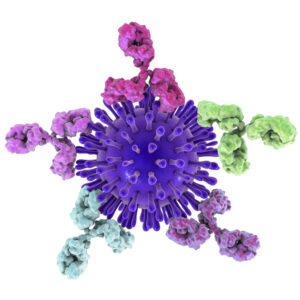Enterovirus
Enteroviruses (EV) are a group of viruses that cause a number of infectious illnesses which are usually mild. However, if they infect the central nervous system, they can cause serious illness. The two most common EV are echovirus and coxsackievirus, but there are several others which also cause polio and hand, foot and mouth disease (HFMD). Enterovirus A71 (EV71) is one of the main causative agents of HFMD, a highly infectious, global disease that predominantly affects children under the age of five. It is typically a mild, self-limiting, febrile disease that is characterised by blisters that appear in the mouth and on the hands and feet. EV71 is a neurotrophic virus and infection can lead to neurological complications in HFMD patients that may lead to paralysis, respiratory collapse and death. Non-polio EV are responsible for approximately a quarter of adult aseptic meningitis cases with an identified causative agent. Echovirus serotypes are frequently reported to be responsible for meningitis, but also are responsible for most enterovirus infections.
Enterovirus Background
Enteroviruses (EV) are single-stranded RNA viruses belonging to the Picornaviridae family and are the smallest, non-enveloped viruses known to infect both humans and animals. More than 100 human enterovirus types have been described and they were originally classified into four groups: polioviruses, coxsackievirus A, coxsackievirus B and echoviruses and a group of Enterovirus marked according to their serotype number (66 – 71, 73 – 75, 77, 78). This was based largely on physical structure of the virus particles, cell or tissue culture growth capabilities, and pathogenesis in humans and other animals. This classification system has now been replaced by one based on virus genomic properties. In 2003, the International Committee on Taxonomy of Viruses created a new taxonomy classification. EV was divided into 5 groups of species based on their molecular properties (HEV-A, HEV-B, HEV-C, HEV-D and poliovirus). Virus serotypes still use their original names given before the current reclassification was adopted, for example, coxsackievirus A9, coxsackievirus B4, echovirus 6, and EV-69 are all members of species Enterovirus B.
EV cause a wide variety of diseases, and it is known that non-polio enteroviruses are the most common cause of aseptic meningitis in adults as well as children. EV are responsible for approximately a quarter of adult aseptic meningitis cases with an identified causative agent. Individual EV serotypes are not exclusively associated with particular disease syndromes, but sometimes have a propensity to cause particular symptoms. Echovirus serotypes are frequently reported to be responsible for meningitis, but also are responsible for most enterovirus infections. Among coxsackieviruses, the leading serotypes associated with central nervous system diseases are B1 to B6, A7 and A9.
Enterovirus 71 (EV71) has been identified as one of the main causative agents responsible for large outbreaks of hand, foot, and mouth disease (HFMD) across the Asia-Pacific region. Other members of the genus Enterovirus cause HFMD, including coxsackieviruses A16, A6, A5, A7, A9, A10, B2, and B5, but EV71 is linked to severe complications, including brainstem encephalitis, aseptic meningitis, and pulmonary edema (Caine et al., 2016). As yet, no effective EV-specific antiviral treatments are available, and vaccines are available only against polioviruses. EV71 outbreaks in the Asia-Pacific region has shown that co-infections with other EV and viruses belonging to other families, is common and raises the possibility that some co-infections can increase the severity of disease and change clinical presentation.
References
- Caine et al. (2016). A Single Mutation in the VP1 of Enterovirus 71 Is Responsible for Increased Virulence and Neurotropism in Adult Interferon-Deficient Mice. Journal of Virology Sep 2016, 90 (19) 8592-8604.
- Non-Polio Enterovirus. Centers for Disease Control and Prevention (CDC). November 14, 2018.
- Enterovirus surveillance guidelines. Guidelines for enterovirus surveillance in support of the Polio Eradication Initiative. World Health Organization 2015.
- Factsheet about enteroviruses. European Centre for Disease Prevention and Control (ECDC), 2010.
- Yi EJ et al. 2017. Enterovirus 71 infection and vaccines. Clin Exp Vaccine Res.Jan;6(1):4-14
Enterovirus antigens
We provide an Enterovirus CoxB3 recombinant VP1 protein, a proprietary Enterovirus antigen and an Echovirus antigen, all manufactured in Escherichia coli. Antigens are suitable for use in ELISA and Lateral Flow sandwich immunoassays.
Enterovirus antibodies
We offer a range of EV70, EV71 and pan-EV antibodies and a coxsackievirus antibody, which are suitable for use in laboratory research and vaccine development.
Questions?
Check out our FAQ section for answers to the most frequently asked questions about our website and company.





